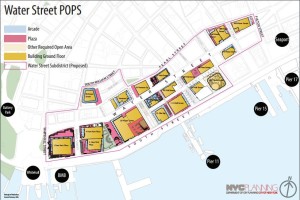
Proposed rezoning of the Water Street POPS. Image credit: Department of City Planning
The proposed zoning text amendment would facilitate the replacement of sheltered outdoor space with commercial storefronts. On March 30th, 2016, the City Planning Commission held a public hearing on an application submitted by the Alliance for Downtown New York, the NYC Economic Development Corporation, and the Department of City Planning to amend the zoning text regulating Manhattan Community District 1’s Special Lower Manhattan District, which includes property sites located within the area bounded by Pearl Street and South William Street to the west, South Street to the east, Fulton Street to the north, and Whitehall Street to the south. The rezoning seeks to activate the neighborhood by filling empty, outdoor space with retail units.
The affected area is known collectively as the Water Street “POPS,” which stands for “privately owned public space.” The Water Street POPS encompasses 20 buildings, which provide 225,000 square feet of “public plazas”—outdoor public spaces that are privately owned by their respective adjacent buildings—and 110,000 square feet of arcades—publicly accessible, outdoor corridors that cover the front of buildings. Developers had been incentivized to build the public plazas and arcades with the provision of bonus floor area. The incentive program was so successful that it yielded an additional 2.5 million square feet of floor area within the Water Street POPS area, all of which would be within the purview of the rezoning proposal. In an effort to revitalize the neighborhood, the proposal would repurpose the public space within the Water Street POPS for commercial retail use by restaurants and “mom and pop” shops.
At the March 30th hearing, Alliance for Downtown New York President Jessica Lappin testified to the need that would be met by the upgraded Water Street POPS. According to Lappin, the portion of downtown Manhattan located East of Broadway if the fastest growing residential neighborhood in lower Manhattan, as displayed by the 122 percent population growth that has been seen since the year 2000. Due to the influx of new residents, the suddenly mixed-use neighborhood needs to adapt by becoming a more active location during the daytime, nighttime, and weekends equally. Lappin noted that the area currently “lacks the vitality seen on other commercial corridors because it fails to engage at the street level,” as shown by its “outdated plazas” and “dark and narrow arcades that don’t provide a real public amenity.” She testified that the Alliance envisions the Water Street POPS area as providing the public with more places to go out to eat and to engage in activities.
Vice Chair Kenneth Knuckles questioned Lappin on the degree to which the Alliance would be involved in ensuring its vision is carried out in terms of the public utility provided by the Water Street POPS. Lappin testified that the Alliance’s plans are to provide outdoor programs, which would enable to public to engage in activities such as bocci ball and giant connect four, and even play in an urban beach.
Commissioner Larisa Ortiz asked Lappin about the Alliance’s “sense of demand” for the retail space that would be created. Lappin’s response was that the geographic area is in demand for retail usage, but only if the commercial space is altered. Lappin noted that the merchants currently occupying some of the “set-back spaces” are “struggling,” because the storefronts are difficult to see.
Hardy Adasko, senior vice president of the Planning Department of NYCEDC, testified that the zoning incentive program responsible for the current state of the Water Street POPS was overwhelmingly successful. However, continued Adasko, the zoning incentive program was established in the 1970s, and it is now coming to light that the landscape crafted back then is not best-suited for the Water Street POPS area in the future. He testified that “the question before us is how do we incentivize and create a mechanism for changing it to what we think now will work better on the street,” which he answered as being a “much more active streetscape” and “fewer dead spaces that don’t have a reason for being.”
Diana Switaj, Director of Planning and Land Use at Manhattan Community Board 1, testified in support of the proposal. She noted the several conditions that the community board would like to see included in the new zoning initiative, such as the issuance of a report on the initiative’s efficacy after the first year of its implementation and the inclusion of affordable housing requirements for new residential units that may be built through the zoning initiative.
Alice Blank, a member of Manhattan Community Board 1’s Landmarks Committee and an architect, testified in opposition to the proposal. Her main point of contention was that the zoning proposal would cause the elimination of the shielded, outdoor space provided by the arcade to make way for commercial properties. Blank questioned: “In a city where we can all be comfortable outdoors for three out of four seasons, why should the public give up public, outdoor areas, particularly the rare, sheltered ones?”
Manhattan Community Board 1 narrowly voted to recommend approval of the zoning proposal by a one-vote margin. The divisive views among the community board were portrayed in the opposing testimony presented at the March 30th hearing.
CPC: Water Street Upgrades Text Amendment (160166-ZRM) (March 30, 2016).
By: Jessica Soultanian-Braunstein (Jessica is the CityLaw Fellow and a New York Law School Graduate, Class of 2015)

